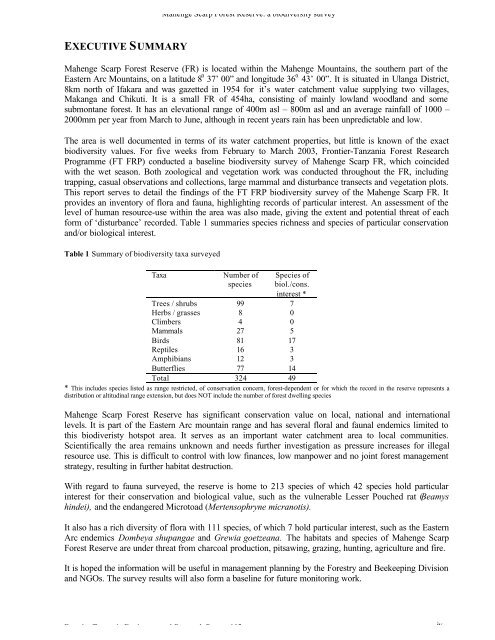Mahenge Scarp Forest Reserve - Frontier-publications.co.uk
Mahenge Scarp Forest Reserve - Frontier-publications.co.uk
Mahenge Scarp Forest Reserve - Frontier-publications.co.uk
Create successful ePaper yourself
Turn your PDF publications into a flip-book with our unique Google optimized e-Paper software.
<strong>Mahenge</strong> <strong>Scarp</strong> <strong>Forest</strong> <strong>Reserve</strong>: a biodiversity survey<br />
EXECUTIVE SUMMARY<br />
<strong>Mahenge</strong> <strong>Scarp</strong> <strong>Forest</strong> <strong>Reserve</strong> (FR) is located within the <strong>Mahenge</strong> Mountains, the southern part of the<br />
Eastern Arc Mountains, on a latitude 8 0 37’ 00” and longitude 36 0 43’ 00”. It is situated in Ulanga District,<br />
8km north of Ifakara and was gazetted in 1954 for it’s water catchment value supplying two villages,<br />
Makanga and Chikuti. It is a small FR of 454ha, <strong>co</strong>nsisting of mainly lowland woodland and some<br />
submontane forest. It has an elevational range of 400m asl – 800m asl and an average rainfall of 1000 –<br />
2000mm per year from March to June, although in recent years rain has been unpredictable and low.<br />
The area is well documented in terms of its water catchment properties, but little is known of the exact<br />
biodiversity values. For five weeks from February to March 2003, <strong>Frontier</strong>-Tanzania <strong>Forest</strong> Research<br />
Programme (FT FRP) <strong>co</strong>nducted a baseline biodiversity survey of <strong>Mahenge</strong> <strong>Scarp</strong> FR, which <strong>co</strong>incided<br />
with the wet season. Both zoological and vegetation work was <strong>co</strong>nducted throughout the FR, including<br />
trapping, casual observations and <strong>co</strong>llections, large mammal and disturbance transects and vegetation plots.<br />
This report serves to detail the findings of the FT FRP biodiversity survey of the <strong>Mahenge</strong> <strong>Scarp</strong> FR. It<br />
provides an inventory of flora and fauna, highlighting re<strong>co</strong>rds of particular interest. An assessment of the<br />
level of human resource-use within the area was also made, giving the extent and potential threat of each<br />
form of ‘disturbance’ re<strong>co</strong>rded. Table 1 summaries species richness and species of particular <strong>co</strong>nservation<br />
and/or biological interest.<br />
Table 1 Summary of biodiversity taxa surveyed<br />
Taxa<br />
Number of<br />
species<br />
Species of<br />
biol./<strong>co</strong>ns.<br />
interest *<br />
Trees / shrubs 99 7<br />
Herbs / grasses 8 0<br />
Climbers 4 0<br />
Mammals 27 5<br />
Birds 81 17<br />
Reptiles 16 3<br />
Amphibians 12 3<br />
Butterflies 77 14<br />
Total 324 49<br />
* This includes species listed as range restricted, of <strong>co</strong>nservation <strong>co</strong>ncern, forest-dependent or for which the re<strong>co</strong>rd in the reserve represents a<br />
distribution or altitudinal range extension, but does NOT include the number of forest dwelling species<br />
<strong>Mahenge</strong> <strong>Scarp</strong> <strong>Forest</strong> <strong>Reserve</strong> has significant <strong>co</strong>nservation value on local, national and international<br />
levels. It is part of the Eastern Arc mountain range and has several floral and faunal endemics limited to<br />
this biodiveristy hotspot area. It serves as an important water catchment area to local <strong>co</strong>mmunities.<br />
Scientifically the area remains unknown and needs further investigation as pressure increases for illegal<br />
resource use. This is difficult to <strong>co</strong>ntrol with low finances, low manpower and no joint forest management<br />
strategy, resulting in further habitat destruction.<br />
With regard to fauna surveyed, the reserve is home to 213 species of which 42 species hold particular<br />
interest for their <strong>co</strong>nservation and biological value, such as the vulnerable Lesser Pouched rat (Beamys<br />
hindei), and the endangered Microtoad (Mertensophryne micranotis).<br />
It also has a rich diversity of flora with 111 species, of which 7 hold particular interest, such as the Eastern<br />
Arc endemics Dombeya shupangae and Grewia goetzeana. The habitats and species of <strong>Mahenge</strong> <strong>Scarp</strong><br />
<strong>Forest</strong> <strong>Reserve</strong> are under threat from char<strong>co</strong>al production, pitsawing, grazing, hunting, agriculture and fire.<br />
It is hoped the information will be useful in management planning by the <strong>Forest</strong>ry and Beekeeping Division<br />
and NGOs. The survey results will also form a baseline for future monitoring work.<br />
<strong>Frontier</strong> Tanzania Environmental Research Report 107<br />
iv

















